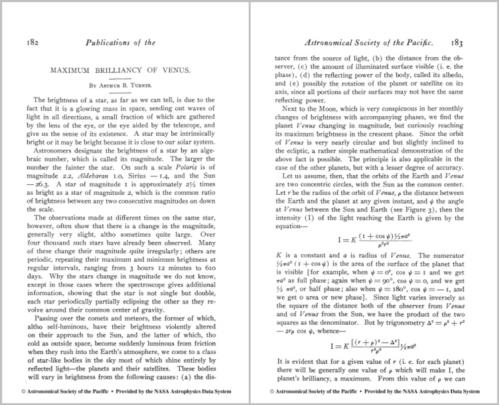
NavList:
A Community Devoted to the Preservation and Practice of Celestial Navigation and Other Methods of Traditional Wayfinding
From: Frank Reed
Date: 2020 Apr 21, 14:59 -0700
Astronomers have been working out the timing of maximum brightness or brilliance or brilliancy (seemingly only used for Venus) for a couple of centuries. It's a trade-off between angular size, which gets larger as Venus approaches the Earth, and phase, which becomes more crescent-like with less illuminated area as Venus approaches Earth. There is an optimal time past greatest elongation and before inferior conjunction when the planet is brightest. Here's an article from 106 years ago that some of you may enjoy: https://adsabs.harvard.edu/full/1914PASP...26..182T. It's mathematical, but relatively basic (first two pages attached).
Does it impact visibility in daylight? Looking at the data for this year, for about 30 days before "maximum brilliancy" and for about 18 days after, Venus will be in the magnitude range -4.53 to -4.73 and back to -4.53. Visual observers cannot detect a difference of 0.2 magnitudes without comparison stars and even then 0.2 magnitudes is a tough call. All of April has been and will continue to be an excellent time to see Venus in daylight. Note that the elongation of Venus (the angular distance from the Sun) is now falling, and that works against daylight visibility. So perhaps the ideal day to see it in daylight was a week ago. Maybe it's tomorrow. There's not much difference, and if any of you in the northern hemisphere have not been able to see it "naked eye" in daylight yet this month, then "you're doing it wrong!" :) But don't worry, you can try through early May. For observers in urban areas, especially with many diesel vehicles, and areas downwind from industrial polluters, this corona shutdown is a great opportunity for two reasons: 1) less smog, less aerosol pollution means bluer skies and greater contrast when looking for Venus, and 2) you probably have time to kill in the middle of the day. :/
Frank Reed







